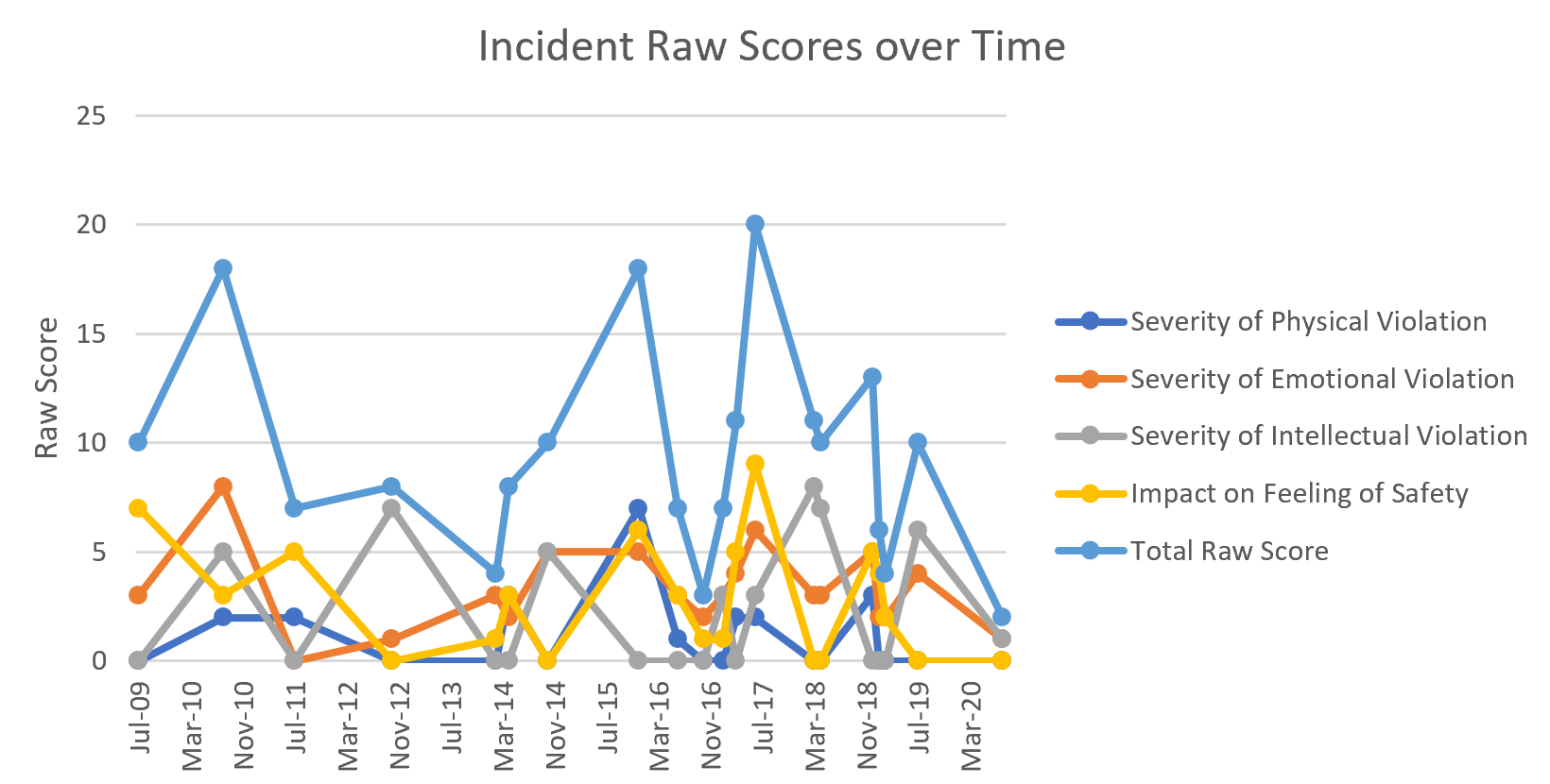Being a recipient of gender discrimination, sexual harassment, and sexual assault does not say much about me as a person but how I’ve coped and lived with these experience has dictated my activism around gender equity. Before we delve into the show-and-tell portion of the program, here are my goals:
For those who have been assaulted, harassed, or discriminated against, I want for us to 1) deal with these traumas in the way we see fit for ourselves, 2) speak about these experiences with clarity and confidence when we want to, 3) prevent these traumas from happening to others, and 4) support people who have been through these experiences. My little act of activism is to speak about my experiences with clarity and confidence for other victims to not feel alone, for my peers/colleagues to realize they know someone, and for me to feel like I’m turning something negative into something constructive.
For those who have not experienced sexual assault, harassment, or gender discrimination, I want to 1) define these terms, 2) illustrate the pervasiveness of these types of experiences, and 3) detail the range or spectrum of each type of experience. I want for you too to identify, prevent, and protect those you see who are being assaulted, harassed, or discriminated against.
This figure displays the public consciousness of sexual harassment and specific sexually harassing behaviors. For an in-depth discussion of these issues, check out our Sexual Harassment of Women report, which explores the influence of sexual harassment in academia on the career advancement of women in the scientific, technical, and medical workforce.
Definition
In 2018, the National Academy of Science published a report, Sexual Harassment of Women: Climate, Culture, and Consequences in Academic Sciences, Engineering, and Medicine, where I will draw my definitions:
Sexual harassment (a form of discrimination) is composed of three categories of behavior: (1) gender harassment (verbal and nonverbal behaviors that convey hostility, objectification, exclusion, or second-class status about members of one gender), (2) unwanted sexual attention (verbal or physical unwelcome sexual advances, which can include assault), and (3) sexual coercion (when favorable professional or educational treatment is conditioned on sexual activity). Harassing behavior can be either direct (targeted at an individual) or ambient (a general level of sexual harassment in an environment).
Sexual coercion is the most severe act and what we hear about in the news; Harvey Weinstein is a notable offender and his horrendous actions sparked the #MeToo movement. Gender harassment is the most commonly experienced form of sexual harassment, which includes verbal insults like microaggressions. I will speak about the experiences that were targeted at me but do note, harassing behavior can be ambient, which is just as pernicious and harder to identify, then fight.
The Consequences of Sexual Harassment
Sexual harassment affects the individual who experienced trauma, the proximal community that supports the individual, and the quality of science the individual was trying to contribute to. I’ll speak from experience that after I experienced sexual harassment, I spent time dissecting what exactly happened, if it counts as harassment, if I could have brought it onto myself, whether I can or should do anything about it. This emotional work is exhausting and takes away from my research, my productivity as an individual. When I felt brave enough, I reached out to my support network, my friends, family, and colleagues, to weigh in. I know they don’t want to see me like this and they don’t want to talk about such heavy topics; this negativity took away from their emotional bandwidth and time as well. I have not exited the academy yet but many women do, pointing at bad actors and poor institutional support to provide justice.
Even if you don’t care about me as an individual, think about all the diverse perspectives we are losing; we have mathematically proven that “groups of diverse problem solvers can outperform groups of [homogeneous] high-ability problem solvers”. Women are still underrepresented in many fields of the academy, and if we take in intersectional identities, this underrepresentation compounds. Science, after all, is not a machine that drives itself; people drive science and science is improved by including more diverse perspectives.
Total severity score of gender discrimination, sexual harassment, and sexual assault out of 30 possible points, with each subscore of physical , emotional, and intellectual violation out of 10. Before plotting this timeseries, I would have thought that the incidents would feel less severe over time but the series would suggest periodic frequency with random severity.
My Experiences
My goal is not to air dirty laundry for you to gawk at but for you to read through my log of experiences as a proxy for living in a lady academic’s shoes. I started a log of incidents because I was trying to make sense of what was happening to me and I wanted evidence to support me in case I ever wanted to seek justice. Because I love data and love formalizing abstract concepts, I dated each incident, classified the incident as <gender discrimination, sexual harassment, or sexual assault>, quantified the severity of <physical violation, emotional violation, intellectual violation>, impact on feeling of safety, the setting, and the demographics of my perpetrator. I’ve blocked out names, institutions, and some personal events but I’ve left space in the log to show how much metaphorical space and weight each incident has in my memory.
As you scroll through the table of incidents, notice the spectrum of severity, from a random catcall to an entire night’s interaction with a person who made me feel unsafe, who physically touched me even though I spoke up four times about my discomfort. Notice the frequency of which these events keep occurring. Notice the different ways an event can affect a person, physically, emotionally, intellectually, and in the perception of safety.
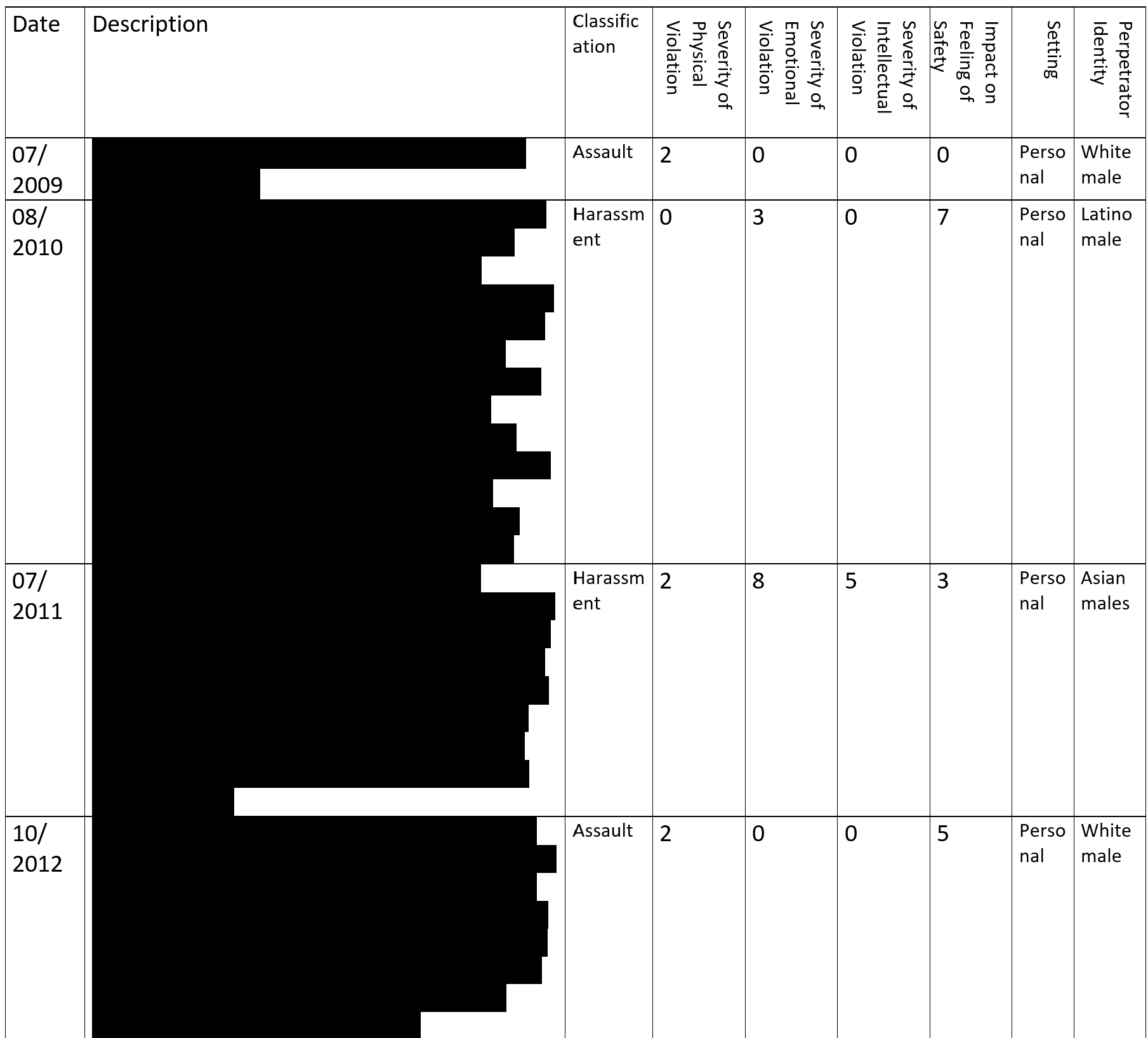
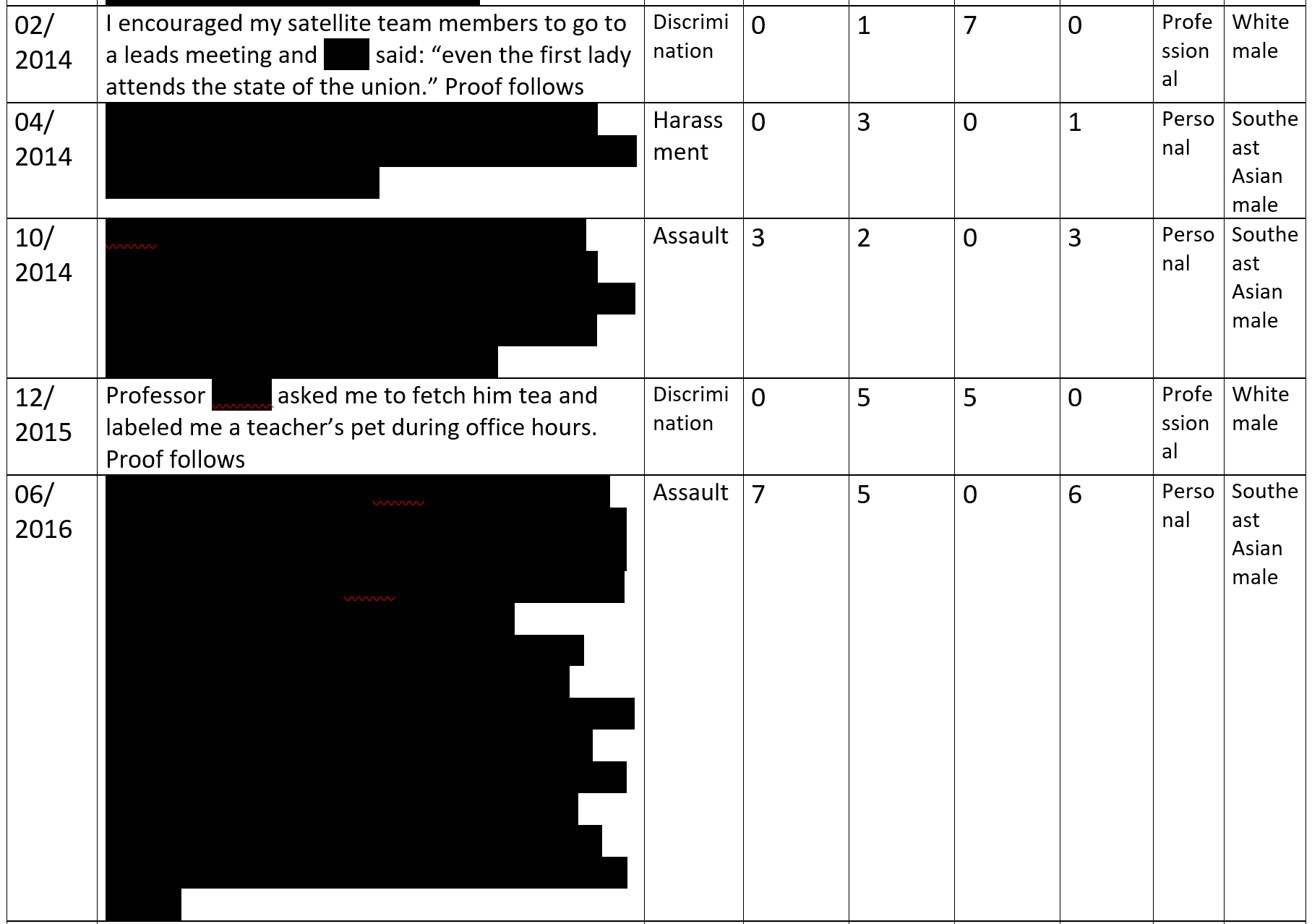
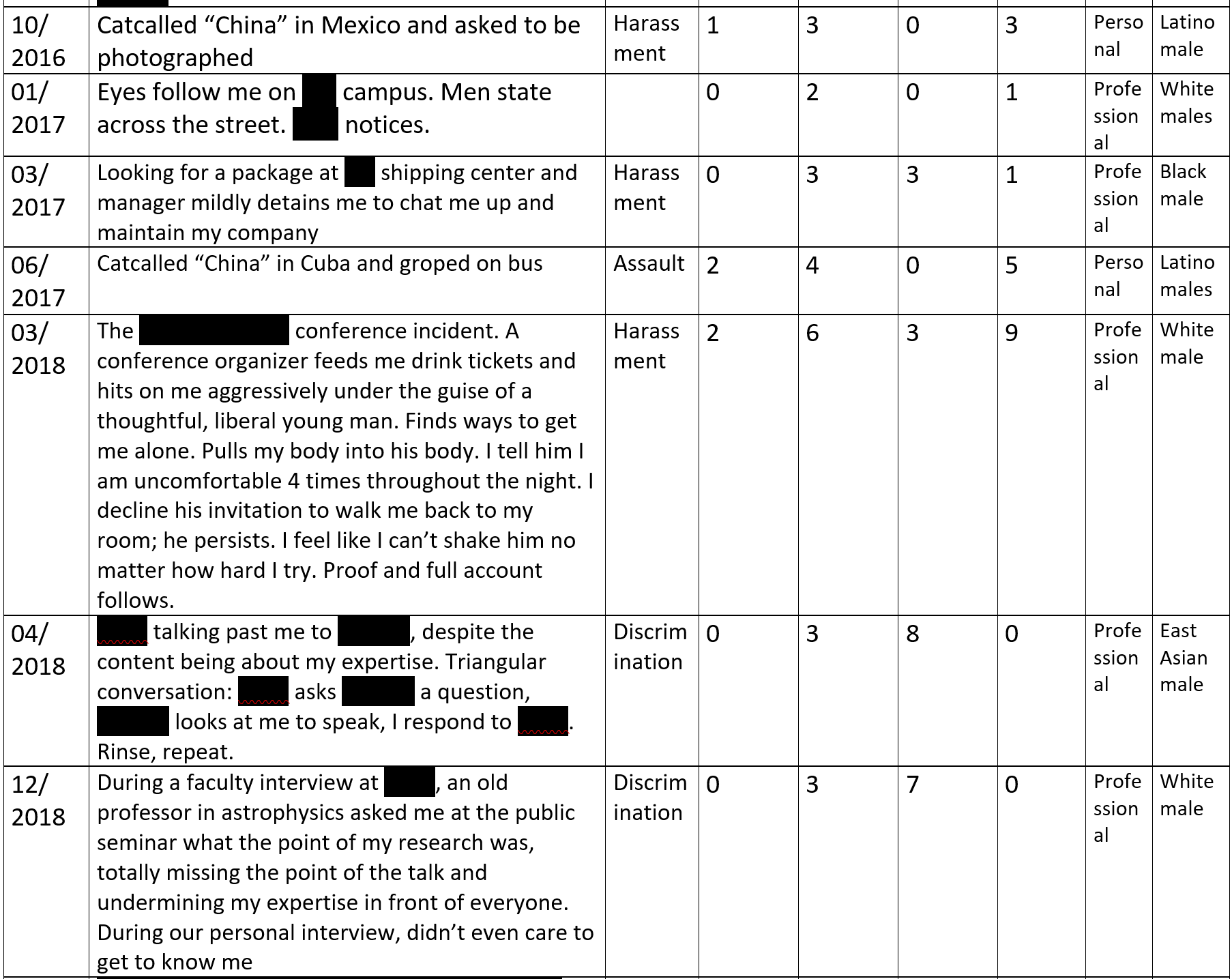
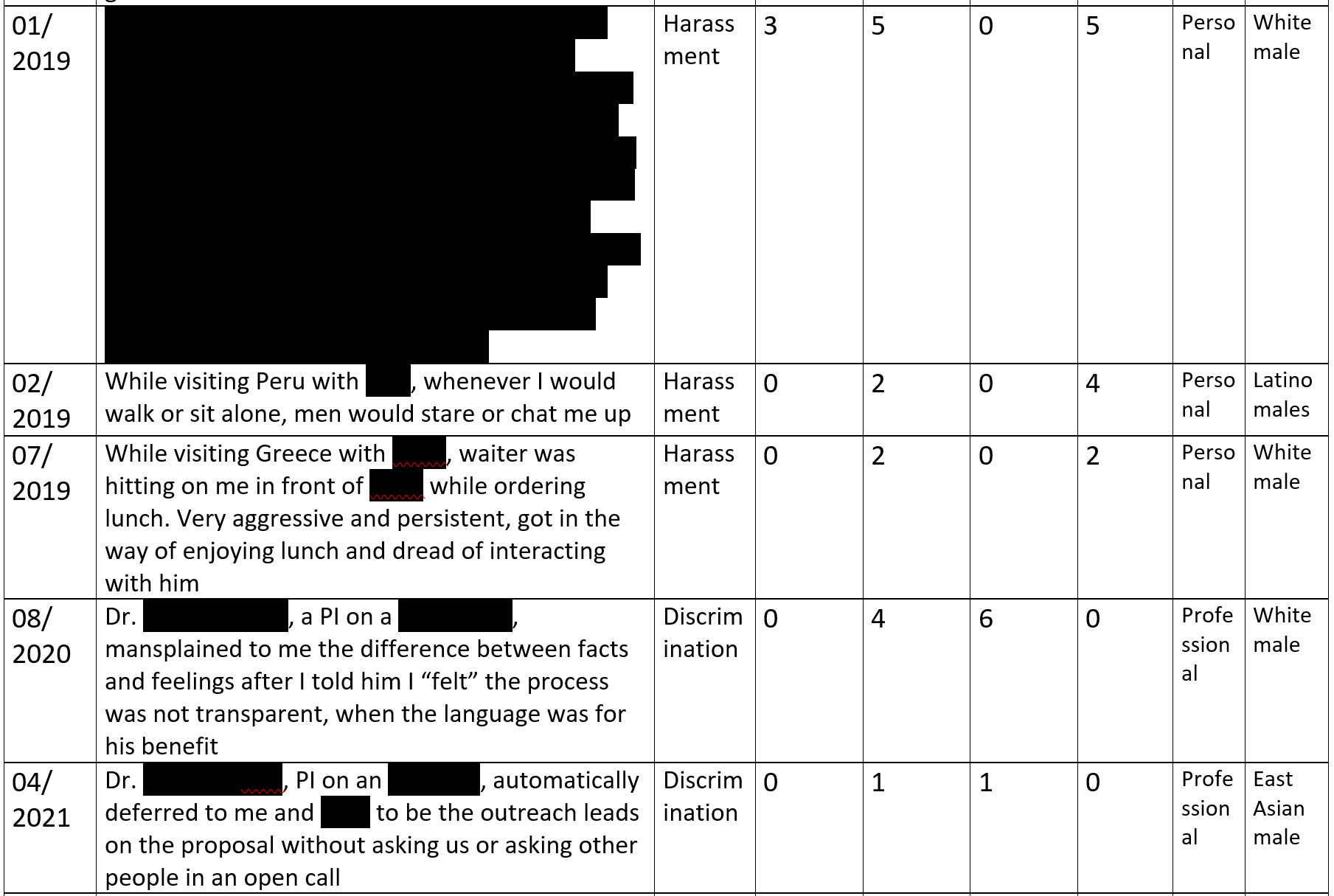
How We Move Forward Together
My pleas to you, the silent majority, the bystanders, is to take the following actions in increasing maturity:
Look at this cute face. This is me at the Hawai’i Space Flight Lab’s clean room with the lovely Mr. Lloyd French behind me, peeking through the testbed shield. Do these things so more people like me can stay in spaces like this.
Please learn about gender inequity. Watch the Picture a Scientist film. Read the National Academy of Science Sexual Harassment Report and this article, Sexism in the Academy. Talk to women in academia. Better to talk about this topic than pretend sexual harassment doesn’t happen. Odds are (81%) that the woman you are talking to has experienced some form of sexual harassment during their lifetime. If you’re curious about how to measure the attitudes and beliefs that may precipitate sexual assault, refer to Table 3. Illinois Rape Myth Acceptance Scale (IRMA) in Fejervary’s thesis.
Please have expectations of how others should conduct themselves in the workplace and beyond. Communicate those expectations. A conversation, an agreed-upon code of conduct can do wonders in explicitly defining gray areas.
Please question the actions of your peers. Keep your colleagues and peers accountable. Just practice saying ew when you feel like something is off in a meeting. If it feels yucky, it is yucky.
Please intervene. Take swift action if you see something and risk seeming presumptuous in intervening than assuming a victim has it under control. I can tell you that even if they, the victim, spoke up, their actions do not guarantee their safety, but your eyes and attention do. I wish so much that more women, who are more likely to understand what I was going through at the conference, were present to see me. By exposing you to what you should look out for, maybe you could have seen me too.
Please listen to victims/survivors and meet them where they are at in their cycle from coping and self-care to reporting and activism. We do not impose every survivor on our image of what a survivor should be. Honestly, survivors are very likely in a toxic power dynamic, putting them in a tenuous situation or at risk of retaliation.
Please empathize with survivors, like students or colleagues, and understand their productivity may be affected. These events can have a surprising toll and burden on a person. After my conference event, I cried intensely the day after, moderately for a week, and lightly for months. It’s been a few years now but I still tear up when admitting I’ve been harassed and touched against my will. These physical tears are just a symptom of the heavy emotional toll on the inside: shame, hypersensitivity, withdrawal, distraction, and anger.
Please support reports of incidents if you’re a witness or just support the act of reporting at your institutions. My friend helped me anonymously report the conference incident to the conference committee organizers by stripping any identifiable meta-data from a PDF and forwarding this report.
Please get involved in activism to advocate for those who are less privileged in all identities, not just women.


